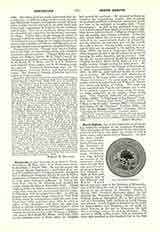

Northcote, JAMES SPENCER, b. at Feniton Court, Devonshire, May 26, 1821; d. at Stoke-upon-Trent, Staffordshire, March 3, 1907. He was the second son of George Barons Northcote, a gentleman of an ancient Devonshire family of Norman descent. Educated first at Ilmington Grammar School, he won in 1837 a scholarship at Corpus Christi College, Oxford, where he came under Newman’s influence. In 1841 he became B.A., and in the following year married his cousin, Susannah Spencer Ruscombe Poole. Taking Anglican Orders in 1844 he accepted a curacy at Ilfracombe; but when his wife was received into the Catholic Church in 1845, he resigned his office. In 1846 he himself was converted, being received at Prior Park College, where he continued as a master for some time. From June, 1852, until September, 1854, he acted as editor of the “Rambler“, and about the same time helped to edit the well-known “Clifton Tracts”. After his wife’s death in 1853 he devoted himself to preparation for the priesthood, first under Newman at Edgbaston, then at the Collegio Pio, Rome. On July 29, 1855, he was ordained priest at Stone, where his daughter had entered the novitiate. He returned to Rome to complete his ecclesiastical studies, also acquiring the profound erudition in Christian antiquities which was later to be enshrined in his great work “Roma Sotterranea”. In 1857 he was appointed to the mission of Stoke-upon-Trent, which he served until 1860, when he was called to Oscott College as vice-president, and six months later became president. Under his rule, which lasted for seventeen years, the college entered on an unprecedented degree of prosperity, and his influence on education was felt far outside the walls of Oscott. Failing health caused him to resign in 1876, and he returned to the mission, first at Stone (1878), and then at Stoke-upon-Trent (1881), where he spent the rest of his life revered by all for his learning, his noble character, and his sanctity. During the last twenty years of his life he suffered from creeping paralysis, which slowly deprived him of all bodily motion, though leaving his mind intact. He had been made a canon of the Diocese of Birmingham in 1861, canon-theologian in 1862, and provost in 1885. In 1861 the pope conferred on him the doctorate in divinity. Dr. Northcote’s wide scholarship is witnessed to by many works, chief among which is “Roma Sotterranea”, the great work on the Catacombs, written in conjunction with William R. Brown-low, afterwards Bishop of Clifton. This work has been translated into French and German; and it won for its authors recognition as being among the greatest living authorities on the subject. Other works were: “The Fourfold Difficulty of Anglicanism” (Derby, 1846); “A Pilgrimage to La Salette” (London, 1852); “Roman Catacombs” (London, 1857); “Mary in the Gospels” (London, 1867); “Celebrated Sanctuaries of the Madonna” (London, 1868); “A Visit to the Roman Catacombs” (London, 1877); “Epitaphs of the Catacombs” (London, 1878).
EDWIN BURTON

